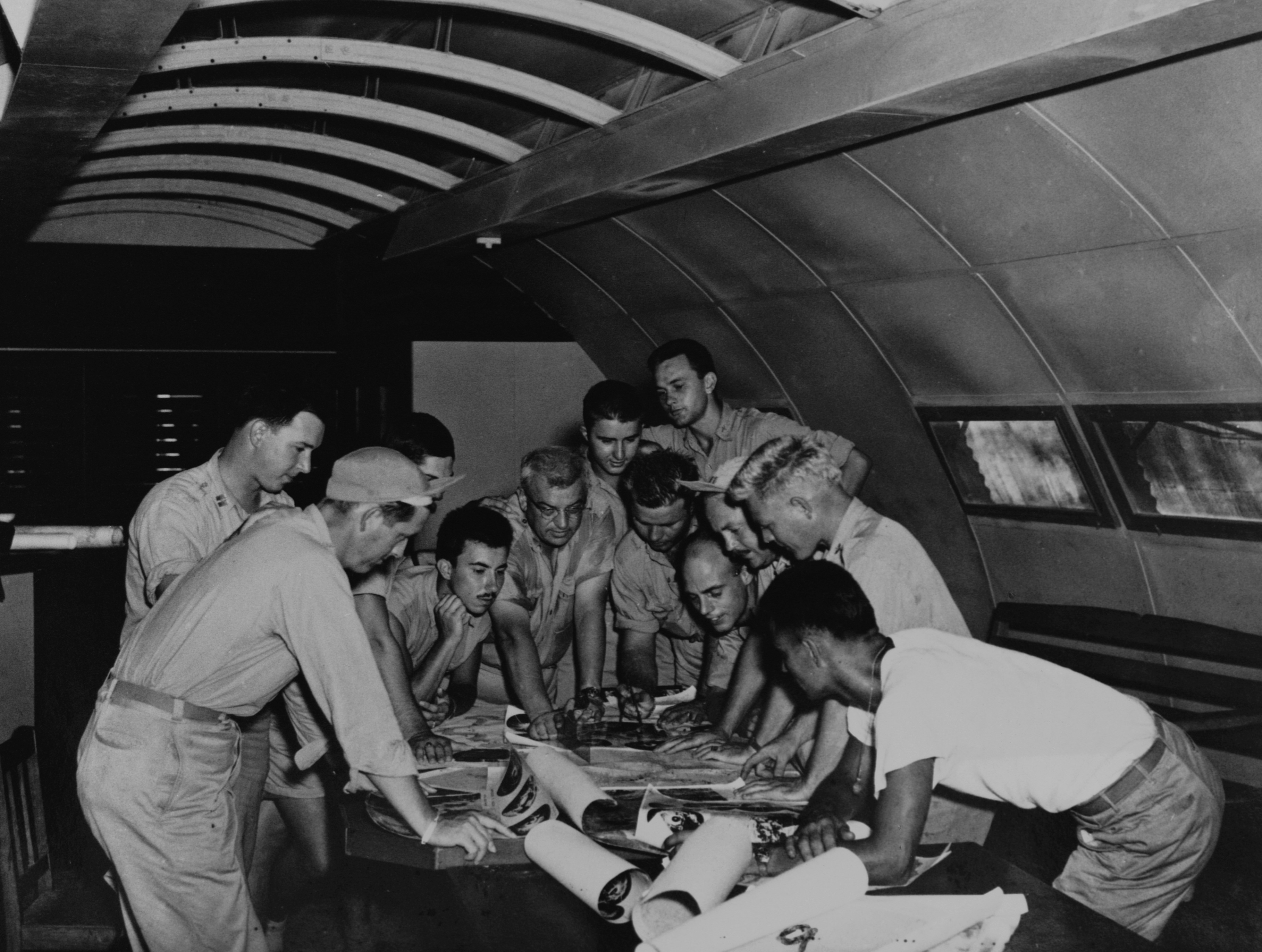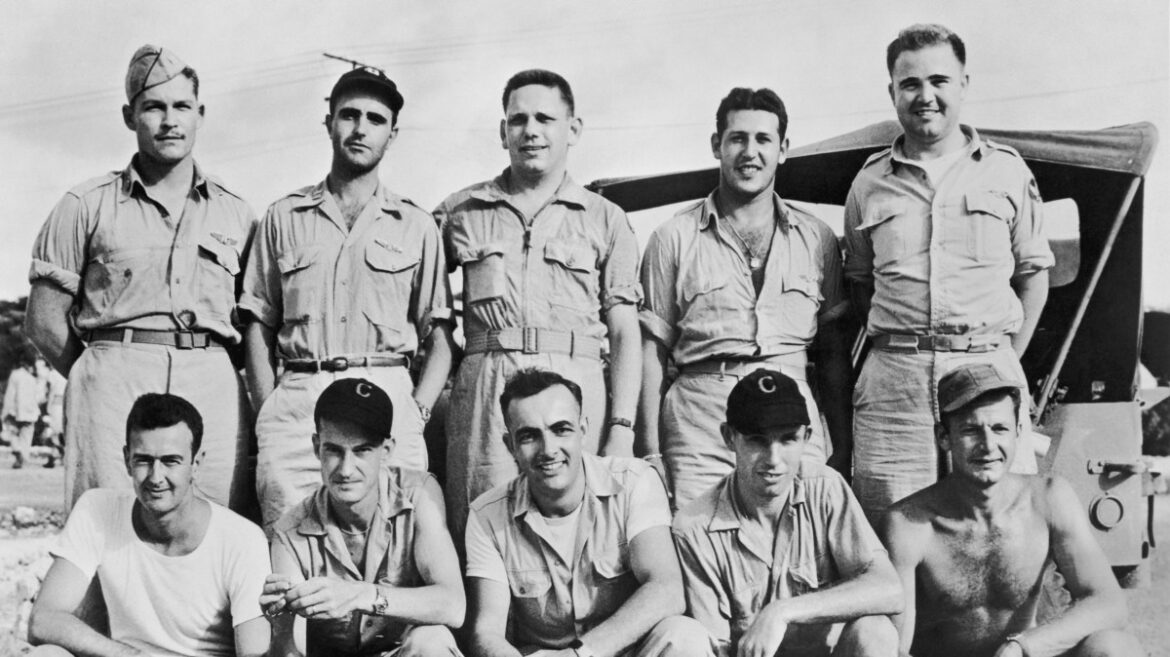Aboard The Great Artiste, which will film the bombing, only two men have a clear idea of what they are about to witness. Lawrence H Johnston, a scientific observer, was at the Trinity Test of the first bomb and at Hiroshima. Alongside him is William Laurence, the science reporter of the New York Times, who was also at the Trinity Test.
“Does one feel any pity or compassion for the poor devils about to die?” Laurence wonders. “Not when one thinks of Pearl Harbor and of the death march on Bataan.” The horrors of the Japanese brutality in the war have left deep scars, but Laurence is also in a philosophical mood. He has spent some of the flight chatting with the crew about Thomas Aquinas and Plato.
Education is on the mind of Reiko Hada, a nine-year-old girl in Nagasaki. She is heading to her local temple, which is operating as a school. She will study for 40 minutes before returning home.
The planes are now nearing their target, but that is 100 miles from Reiko Hada.
The convoy of American bombers has been in the air for more than six hours since taking off from Tinian, a Pacific island about 1,500 miles southeast of Japan. Just before its departure, however, an issue was spotted with Bockscar.
A faulty pump means that the reserve fuel supply cannot be accessed. This was discovered after the bomb had already been loaded, and to remove it would have meant critical delay to the mission. They decided to proceed, safe in the knowledge that they had enough fuel to reach the target and then get to the occupied island of Iwo Jima.
However, they have had to fly high to avoid bad weather and have just spent 40 minutes at the botched rendezvous at Yakushima. The fuel gauge is trickling down, and it is still half an hour before they reach their target. Making Iwo Jima is looking increasingly unlikely.
Hiroshima survivors fear second bomb
Some survivors of the Hiroshima bomb have made their way here, to Nagasaki
ULLSTEIN BILD/GETTY IMAGES
One bomb has bred well-founded fear of another. America has decided that it must demonstrate its ability to deploy the power of these bombs more than once. In Nagasaki, preparations for such a strike are under way.
Nagano Wakamatsu, governor of the Nagasaki prefecture, has assembled local officials to discuss the new threat and plan a public information campaign in the coming days. Survivors of Hiroshima have even made it to Nagasaki, telling tales of blinding light and utter devastation. One even suggests that the sight of a single plane should now see everyone sent into mass shelters, lest it be carrying the second atomic bomb.
The bomber Bockscar is carrying that second bomb, one which is 40 per cent more powerful than the Hiroshima bomb. However, the plane has a problem.
It has been three days since a new horror dawned on the world when the United States dropped an atomic bomb on Hiroshima. About 80,000 people died instantaneously and everything within a half-mile radius was wiped out. Survivors, who suffered terrible burns and other injuries in the almighty blast, are now beginning to fall ill with a mysterious sickness. The death toll will rise further.
Nevertheless, Japan has not surrendered. The militaristic government remains split 50-50 between those who would give the Allies the unconditional surrender they demand and those who believe Japan can fight its way to another deal. Better terms would be bought by forcing an Allied invasion of Japan, in which maybe more than a million would die. Besides, the anti-peace camp includes many who find the idea of surrender utterly abhorrent.
The Japanese Supreme War Council will meet later today. The American bomber convoy expects to reach its target at about 9.40am.

The flight crews of two planes go over plans for the dropping of the first atomic bombs
CORBIS/GETTY IMAGES
In the morning skies over Yakushima, an island south of the western edge of Japan, two planes have been circling for 40 minutes. The B-29 bombers, called Bockscar and The Great Artiste, are carrying very different cargoes. The Great Artiste is filled with scientific instruments, cameras and even a journalist. Bockscar is carrying a single bomb.
They have been waiting for a third plane, called Big Stink, at this isolated rendezvous point. They can wait no longer. With a waggle of its wings, Bockscar indicates that it is time to proceed. They head north.
Some 170 miles away, the summer sun is waking the city of Nagasaki.


AloJapan.com